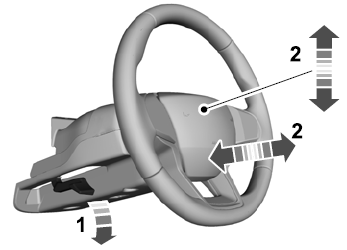Lincoln Aviator: Exterior Lighting / General Procedures - Headlamp Adjustment
Adjustment
-
NOTE: If the flash video link does not load or is incompatible with your browser, a .wmv version of the video can be accessed at: http://www.fordservicecontent.com/Ford_Content/videos/FusionHeadlampAdj2.wmv
Click on the link above to view video.
Click here to view a video version of this procedure.
.png)
mostbet registration
All headlamp types
NOTE: Refer to the Owner's Literature for the headlamp adjustment screw location.
NOTE: Consult your state vehicle inspection manual for recommended tolerance ranges for visual aiming.
NOTE: Horizontal aim is not adjustable.
-
Identify the headlamp type. Vehicles are equipped
with Visually Optically Aligned Left (VOL) or Visually Optically Aligned
Right (VOR) headlamps. Molded in small letters on the headlamp lens is
one of the following: VOL and SAE or VOR and SAE.
-
NOTE: Before starting headlamp adjustment, entry conditions must be met.
-
Vehicle must be on level ground.
-
Tires must be correctly inflated.
-
Vehicle must be normally loaded.
-
Headlamps must be clean.
-
Headlamps must operate correctly.
-
Air suspension switch must be on (if equipped).
-
Vehicle must be on level ground.
-
NOTE: The vertical wall or screen must be a minimum of 3 m (10 ft) wide.
Park the vehicle on a level surface approximately 7.6 m (25 ft) from the vertical wall or screen directly in front of it.
.jpg) |
-
NOTE: The bulb center of the low beam bulb is sometimes marked on the lens (circle, crosshair or other mark) or is the center of the low beam reflector, bulb shield or the low beam projector inner lens.
Measure the center of the headlamp height to ground and record the measurement.
.jpg) |
-
NOTE: Use a 3 m (10 ft) section of masking tape for the horizontal reference line.
-
For vehicles with headlamp bulb center heights
below 95 cm (37.5 inches), place the horizontal reference line equal to
the headlamp bulb center height.
-
For vehicles with headlamp bulb center heights
between 95 cm - 105 cm (37.5 - 41.5 inches), place the horizontal
reference line at the headlamp bulb center height minus 1.3 cm (0.5
inch).
-
For vehicles with headlamp bulb center heights
above 105 cm (41.5 inches), place the horizontal reference line at the
headlamp bulb center height minus 2.5 cm (1.0 inch).
-
For vehicles with headlamp bulb center heights
below 95 cm (37.5 inches), place the horizontal reference line equal to
the headlamp bulb center height.
-
NOTE: Carry out this procedure in a dark environment to effectively see the headlamp beam pattern.
Turn the low beam headlamps on to illuminate the wall or screen and open the hood.
-
NOTE: The cut off of the beam pattern is the horizontal line of the beam pattern where there is MAXIMUM change between light and dark.
On the wall or screen, locate the cut off of the beam pattern.
VOR-type headlamps
NOTE: Procedure applies to both left and right headlamps with VOR molded on lens.
-
NOTE: The appearance of the VOR beam pattern may vary between vehicles.
There is a distinct cutoff in the right portion of the beam pattern.
-
-
1 - Horizontal reference line
-
2 - Cut off
-
3 - High intensity zone
-
1 - Horizontal reference line
.jpg) |
-
NOTE: Align one headlamp while covering the other headlamp.
Align the headlamps to the horizontal reference line. Adjust the headlamp as necessary using the headlamp adjusting screw.
-
Repeat the previous step for the remaining headlamp.
VOL-type headlamps
NOTE: Procedure applies to both left and right headlamps with VOL molded on lens.
-
NOTE: The appearance of the VOL beam pattern may vary between vehicles.
For VOL-type headlamps, there is a distinct cutoff in the left portion of the beam pattern. The edge of this cutoff should be positioned 5 CM (2 in) below the horizontal reference line.
-
-
1 - Horizontal reference line
-
2 - Cut off
-
3 - High intensity zone
-
1 - Horizontal reference line
.jpg) |
-
NOTE: Align one headlamp while covering the other headlamp.
Align the headlamps to the horizontal reference line. Adjust the headlamp as necessary using the headlamp adjusting screw.
-
Repeat the previous step for the remaining headlamp.
 General Procedures - Front Fog Lamp Adjustment
General Procedures - Front Fog Lamp Adjustment
Adjustment
NOTE:
Horizontal aim is not adjustable. Consult your state
vehicle inspection center for recommended tolerance ranges for visual
aiming...
 Removal and Installation - Front Fog Lamp
Removal and Installation - Front Fog Lamp
Removal
NOTE:
Removal steps in this procedure may contain installation details.
NOTE:
LH side shown, RH side similar.
Remove the front bumper cover...
Other information:
Lincoln Aviator 2020-2025 Service Manual: Removal and Installation - Second Row Single Seat Backrest Cover - Vehicles With: Second Row Captain Chairs
Special Tool(s) / General Equipment Interior Trim Remover Removal NOTE: LH (left hand) seat shown, RH (right hand) seat similar. Remove the second row seat. Refer to: Second Row Seat - Vehicles With: Second Row Captain Chairs (501-10B Second Row Seats, Removal and Installation)...
Lincoln Aviator 2020-2025 Owners Manual: Disabling Auto-Start-Stop
Press the button on the instrument panel to access the Auto-Start-Stop feature on the touchscreen. Use the touchscreen to deactivate the feature. Deactivating the feature lasts only 1 key cycle. Use the touchscreen to restore Auto-Start-Stop function...
Categories
- Manuals Home
- Lincoln Aviator Owners Manual
- Lincoln Aviator Service Manual
- USB Port and Power Point Locations
- Interior Lamps
- Resetting the System
- New on site
- Most important about car
Adjusting the Steering Wheel - Vehicles With: Manual Adjustable Steering Column
WARNING: Do not adjust the steering wheel when your vehicle is moving.
Note: Make sure that you are sitting in the correct position.
Unlock the steering column. Adjust the steering wheel to the desired position.
